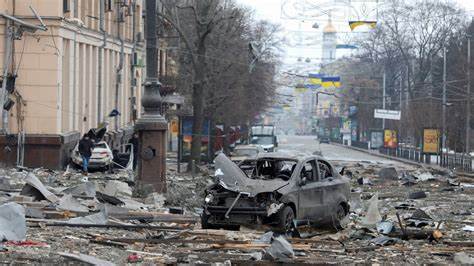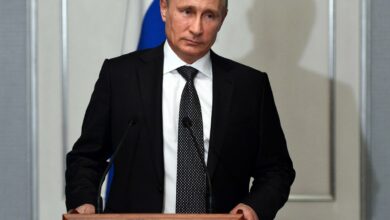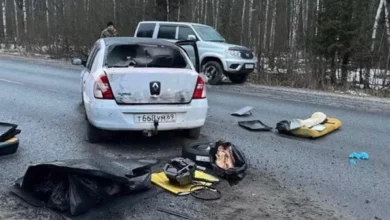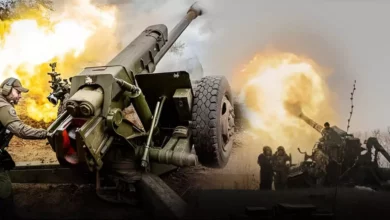‘Kharkiv is their priority’: Deadly Russian attacks hit Ukraine’s northeast

Ukraine’s Kharkiv A Russian missile tore off a large portion of a five-story apartment building like a gigantic scalpel from a bizarre horror film, leaving 10 people dead and 60 injured.
Rescue personnel discovered the victims buried beneath the debris that once comprised their apartments’ walls, ceilings, and furniture after extinguishing the fire caused by last week’s predawn attack.
The soot and dust had turned one of the distraught rescue workers’ hands and uniform black. “We dug out a guy, alive, but his family – a wife and an eight-year-old daughter – were dead,” he told Al Jazeera on Wednesday.
Just 40 kilometers (25 miles) from the Russian border, in northern Kharkiv, the second-largest city in Ukraine, Building 7 was struck by the explosion.
The largest attack on Kharkiv since the start of the war 23 months ago, according to Ukrainian officials, involved 15 Russian missiles of three different types aimed at the city.
There were modified S-300 missiles, X-22 hypersonic missiles intended to destroy warships, and components of air defense systems that intercept and destroy other missiles in midair.
The largest and deadliest weaponry was the $3 million, 7-meter-long, nearly 4-ton Iskanders that could hold a nuclear warhead or up to 480 kg (1,058 pounds) of explosives.
Russia “most likely” used an S-300 missile, according to a military expert, although Ukrainian officials have not yet disclosed what kind of missile struck Building 7.
Lieutenant-General Ihor Romanenko, the former deputy chief of Ukraine’s General Staff of the Armed Forces, told Al Jazeera that the claims made were inaccurate and that there was psychological and moral pressure to destroy the city even more.
“They prioritize Kharkiv because [President Vladimir] Putin cannot accept that a city with a Russian language did not want to join the Russian world,” he stated.
Moscow routinely disputes that it attacked civilians.
According to Kremlin spokesman Dmitry Peskov, Russia “doesn’t hit civilian infrastructure and residential areas, unlike the Kyiv regime.”
Russia reportedly carried out “pinpointed strikes on the quarters for mercenaries,” according to the news agency Itar Tass.
Hitting Kharkiv
The most vulnerable urban center in Ukraine is the city, which had 1.5 million residents before the war.
It is surrounded by Russia to the north and east, and the Luhansk region, which Moscow annexed, is roughly 150 kilometers (90 miles) to the southeast.
Officials said that on January 23, blasts and shockwaves throughout the region broke nearly 5,000 windows in 222 buildings.
Working quickly and methodically, communal workers in Building 7 pulled out razor-sharp glass shards and filled in every gaping hole with yellow, honeycomb-like strand board rectangles to keep the biting cold at bay.
They fixed broken entrance doors, looked for natural gas leaks in each apartment, and began removing bricks that had been split in half as well as glass, plastic, and other debris.
It was routine as usual to the point of weariness.
According to Vera Fyodorovna, the district head of communal services, “their salaries are 5,400 hryvnia [$145] a month, but the amount of work is colossal – to collect it all, load [onto trucks], and take away.”
In the vicinity of Building 7, two excavators were searching for debris, merely 30 meters (roughly 100 feet) from the location of another Russian bomb that fell in April 2022.
Russian forces have attempted to take control of Kharkiv since the first day of the full-scale invasion, sending armed personnel carriers nearly into the city center.
Moscow has sent in ballistic and cruise missiles, strategic bombers, and drones manufactured in Iran or Russia that can cross the border into the city in a matter of minutes.
Kharkiv is still essentially defenseless in comparison to Kyiv, the capital, which received cutting-edge Western air defense systems in a matter of months.
Authorities and locals have had to adjust swiftly because any delays result in fatalities.
The city’s subway network functioned as a bomb shelter around the clock, with certain stations doubling as classrooms for kids while the air raids were underway.
It was forbidden to hold public events, visit museums, or even hold classes in community centers.
Swimming pools and gyms alert their customers to every air raid, but they still give them the option to leave or stay.
Moscow was forced to move the strategic bombers to airfields hundreds of kilometers away from the border by daring Ukrainian missile and drone attacks.
They no longer enter Ukrainian airspace, but their speed increases the altitude at which the missiles are launched.
Residents of Kharkiv are notified via Telegram or Viber channels of any potential trajectories each time satellites detect their takeoff.
Air raid sirens from the past also start howling, but many locals are so accustomed to their high-pitched sound that they just do not wake up.
For this reason, Tamara Karnaukhova didn’t wake up until her balcony door collapsed onto her bed.
The 76-year-old retired woman was unsure about whether to flee or remain in her small one-bedroom apartment in Building 7.
Most of the windows were destroyed by the shockwave, and the front door was harmed.
She told Al Jazeera, “I was confused, not scared.”
She fled downstairs after the explosion, watching as glass cracked beneath her feet and smoke billowed from shattered windows.
Marauders broke into her apartment covertly while she was at her neighbor’s, searching the kitchen but taking nothing of value.
Karnaukhova is still unable to understand Russia’s invasion.
Do they require land? Resources? She pondered out loud. “Everything is already theirs.”
Lost count
Valerii Ivakhno joined a volunteer group as soon as the war started, riding around in a minivan and giving hot drinks, snacks, and porridge to victims of shelling.
He used all of his savings to renovate his mother’s apartment, which was severely damaged in 2022, in the heart of Kharkiv.
However, the newly installed windows were broken on Tuesday morning.
Fortunately, his mother was aware of the “be between two walls” directive and hurried to the hallway just in time to avoid having glass fragments land on her bed.
Ivakhno expressed his gratitude for his father’s death before the invasion. On February 23, 2022, a day early, he was laid to rest.
Ivakhno handed a rescue worker in central Kharkiv some porridge in a paper cup and said, “Dear God, took him away so that he wouldn’t see this shame and horror.”
For his team, every trip to another area that has been shelled is an ongoing nightmare.
Standing next to a historic law school building that had been damaged by Tuesday’s attack and the ensuing fire, his colleague Svetlana Stetsenko remarked, “I’ve lost count of how many times we have done it, how many people we have helped.”
The street they were on was named for the most famous 19th-century poet in Russia, Alexander Pushkin, whose cult is viewed by the majority of Ukrainians as “cultural imperialism.”
Authorities in Kharkiv made the decision to rename the street and the adjacent subway station in honor of Hrigory Skovoroda, a philosopher and educator from Ukraine, on the same day as the attack.








